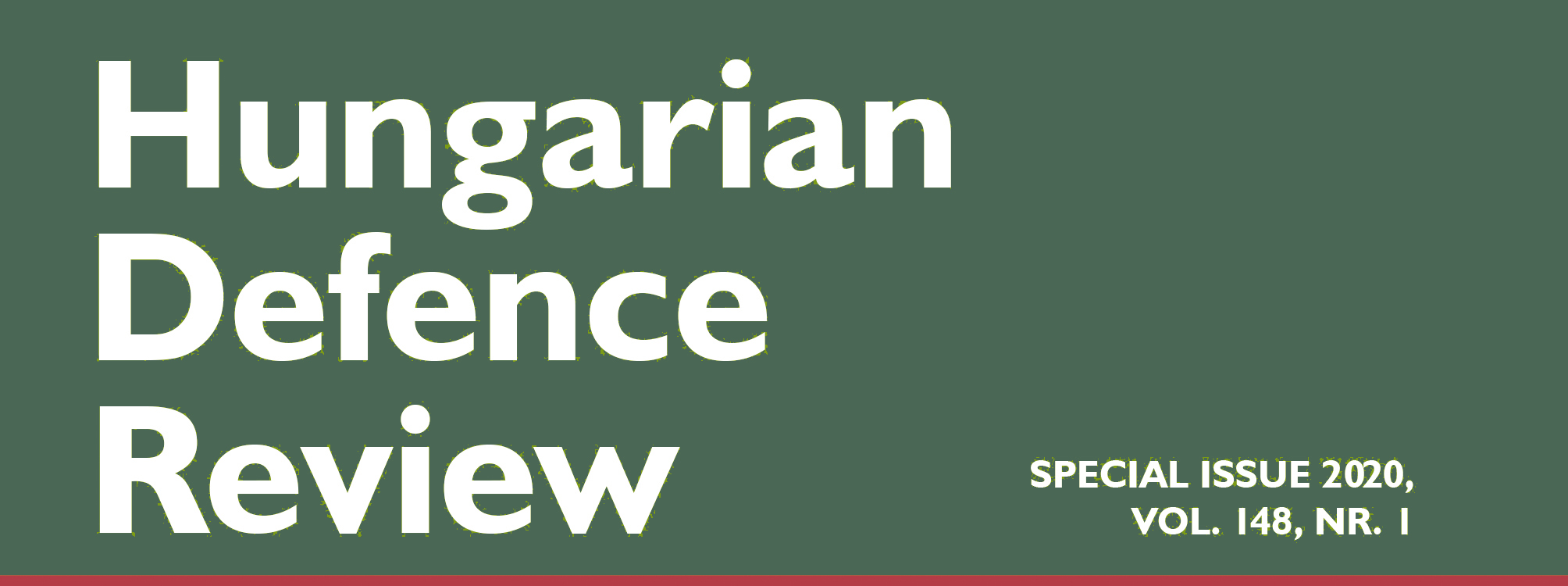A decentralizáció és a blockchain-technológia felhasználási lehetőségei gépi látás és mesterséges intelligencia használatával a védelemigazgatásban, a katonai és a rendvédelmi szervezetekben
DOI:
https://doi.org/10.35926/HDR.2020.1.1Kulcsszavak:
decentralizáció, blokklánc-technológia, gépi tanulás, mesterséges intelligenciaAbsztrakt
A hadtudomány újfajta kihívásokkal szembesült a 20. század végén az internet megjelenésével. A hagyományos biztonságot veszélyeztető kihívások és fenyegetések olyan új értelmezést kaptak a kiberbiztonság mint új fogalom létrejöttével, ami a katonai műszaki tudományok és az informatika szerves átalakulásához vezetett. Ahogy az internet alapjaiban megváltoztatta a világ működését, úgy olyan új technológiák jöttek létre a hálózaton, amelyek iparágak sokaságát forradalmasíthatják. Ilyen innováció az elosztott főkönyv (DLT), a blokklánc-technológia és az ezekre építhető, gépi látáson alapuló mesterséges intelligencia. A blokklánc lehetséges felhasználási területei a katonai műszaki tudományos kihívások sokaságát veti fel. A technológia ugyanis lehetővé teszi a szabad együttműködést kriptográfiai eljárások alkalmazásával az elosztott hálózatokon, állami ellenőrzés nélkül, így akár katonai és védelemigazgatási célokat is szolgálhat.
Hivatkozások
“Arleigh Burke-Class (Aegis) Destroyer”. Naval Technology. https://www.naval-technology.com/projects/burke/Babones, S. “Smart ‘Blockchain Battleships’ Are Right Around the Corner”. The National Interest, 17 May 2018. https://nationalinterest.org/feature/smart-battleships-are-right-around-the-corner-25872
Berta, S. “Maven projekt – a Google könnyen pótolható”. Sg.hu. 6 June 2018. https://sg.hu/cikkek/it-tech/131574/maven-projekt-a-google-konnyen-potolhato
“Blockchains: The great chain of being sure about things”. The Economist, 31 October 2015. https://www.economist.com/briefing/2015/10/31/the-great-chain-of-being-sure-about-things
Bower, L. and Christensen, M. “Disruptive Technologies. Catching the Wave”. Harvard Business Review 74/1. 1995. 43-53. https://hbr.org/1995/01/disruptive-technologies-catching-the-wave
Buterin, V. “Ethereum White Paper: A next-generation smart contract and decentralized application platform”. blockchainlab.com. April 2014. https://blockchainlab.com/pdf/Ethereum_white_paper-a_next_generation_smart_contract_and_decentralized_application_platform-vitalik-buterin.pdf
Cohen, R. “Global Bitcoin Computing Power Now 256 Times Faster Than Top 500 Supercomputers, Combined!”. Forbes, 28 November 2013. https://www.forbes.com/sites/reuvencohen/2013/11/28/global-bitcoin-computing-power-now-256-times-faster-than-top-500-supercomputers-combined/#381f46086e5e
Csetverikov, D. “Digitális képelemzés alapvető algoritmusai”. Budapest: ELTE, 2015. https://www.inf.elte.hu/dstore/document/297/Csetverikovjegyzet.pdf
Cuen, L. “Most Crypto Exchanges Still Don’t Have Clear KYC Policies: Report”. coindesk.com. 27 May 2019. https://www.coindesk.com/most-crypto-exchanges-still-dont-have-clear-kyc-policiesreport
“Distributed Ledger Technology: Beyond block chain”. London: UK Government Office for Science, 2016. https://assets.publishing.service.gov.uk/government/uploads/system/uploads/attachment_data/file/492972/gs-16-1-distributed-ledger-technology.pdf
Dwyer, G. P. “The Economics of Bitcoin and Other Private Digital Currencies”. MPRA Paper 57360. 8 May 2014. https://mpra.ub.uni-muenchen.de/57360/3/MPRA_paper_57360.pdf
Folláth, J., Huszti A. and Pethő A. “Informatikai biztonság és kriptográfia”. Debrecen: Kempelen Farkas Digitális Tankönyvtár, 2011. https://regi.tankonyvtar.hu/hu/tartalom/tamop425/0046_informatikai_biztonsag_es_kriptografia/ch03s04.html
Haber, S. and Stornetta, W. S. “How to time-stamp a digital document”. Journal of Cryptology 3/2. 1991. 99–111. DOI: 10.1007/bf00196791
Haig, Zs. “Az információs hadviselés kialakulása, katonai értelmezése”. Hadtudomány 21/1-2. 2011. 12-28. http://mhtt.eu/hadtudomany/2011/1/HT-2011_1-2_4.pdf
Haig Zs. “Connections between cyber warfare and information operations”. AARMS 8/2. 2009. 329-337. http://m.ludita.uninke.hu/repozitorium/bitstream/handle/11410/1900/13haig.pdf?sequence=1&isAllowed=y
“Hamarosan itthon is beindulhat a mindent látó Nagy Testvér” Népszava, 22 October 2018. https://nepszava.hu/3012846_hamarosan-itthon-is-beindulhat-a-mindent-lato-nagy-testver, Accessed on 20 April 2020.
Huszár, V. “A decentralizáció és a blockchain-technológia felhasználási lehetőségei gépi látás és mesterséges intelligencia használatával a katonai szervezetekben”. Hadmérnök 14/4. 2019. 179-189. DOI: 10.32567/hm.2019.4.11
Kakavand, H., Kost de Sévres, N. and Chilton, B. “The Blockchain Revolution: An Analysis of Regulation and Technology Related to Distributed Ledger Technologies”. Social Science Research Network 2017. DOI: 10.2139/ssrn.2849251 https://www.semanticscholar.org/paper/The-Blockchain-Revolution%3A-An-Analysis-of-and-to-Kakavand-S%C3%A8vres/df2e88f4ce-56c0456e0472d29b8f660fdd865e78
Kovács, L. A kibertér védelme. Budapest: Dialóg Campus, 2018.
MaidSafe. “Evolving Terminology with Evolved Technology: Decentralized versus Distributed”. Medium. 4 December 2015. https://medium.com/safenetwork/evolving-terminology-with-evolved-technology-decentralized-versus-distributed-7f8b4c9eacb
Malik, A., Mahboob, A., Khan, A. and Zubairi, J. “Application of Cyber Security in Emerging C4ISR Systems”. In Crisis Management: Concepts, Methodologies, Tools, and Applications. Hershey: Information Science Reference, 2014. 1705-1738. DOI: 10.4018/978-1-4666-4707-7.ch086
“Mintegy 40 milliárd forintból épül járműipari tesztpálya Zalaegerszegen”. autoszektor.hu. 19 May 2016. http://www.autoszektor.hu/hu/content/mintegy-40-milliard-forintbol-epul-jarmuipari-tesztpalya-zalaegerszegen, Accessed on 15 January 2019.
Pinna, A. and Ruttenberg, W. Distributed ledger technologies in securities posttrading revolution or evolution?. Frankfurt am Main: European Central Bank, 2016. DOI: 10.2866/270533
Péterfalvi, A. “A Nemzeti Adatvédelmi és Információszabadság Hatóság állásfoglalása a blokklánc (»blockchain«) technológia adatvédelmi összefüggéseivel kapcsolatban”. NAIH. 18 July 2017. https://www.naih.hu/files/Adatved_allasfoglalas_naih-2017-3495-2-V.pdf
Satoshi, N. “Bitcoin: A peer-to-peer electronic cash system”. bitcoin.org. 2008. https://bitcoin.org/bitcoin.pdf
Scharre, P. “Killer Robots and Autonomous Weapons With Paul Scharre”. Podcast. Council on Foreign Relations. 1 June 2018. https://www.cfr.org/podcasts/killer-robots-and-autonomous-weapons-paul-scharre
Singer, P. W. and Thatcher, C. “Technology’s dilemmas: Are we wired to respond? an interview with P. W. Singer”. Vanguard, 11 May 2015. 32-34. https://vanguardcanada.com/2015/05/11/technologys-dilemmas-are-we-wired-to-respond/
Swan, M. Blockchain – Blueprint for a new economy. Gravenstein: O’Reilly Media. 2015.
Szabo, N. “Formalizing and securing, Relationships on public networks”. First Monday 2/9. 1997. DOI: 10.5210/fm.v2i9.548
Tapscott, D. and Tapscott, A. Blockchain Revolution: How the Technology Behind Bitcoin is Changing Money, Business, and the World. London: Penguin. 2016.
Williams-Grut, O. “The electricity used to mine bitcoin this year is bigger than the annual usage of 159 countries”. Markets Insider. 27 November 2017. https://markets.businessinsider.com/currencies/news/bitcoin-mining-electricity-usage-2017-11-1009558934
“Zrínyi 2026 Programme to begin”. Ministry of Defence, Hungary. 22 Dec 2016. https://www.kormany.hu/en/ministry-of-defence/news/zrinyi-2026-programme-to-begin


